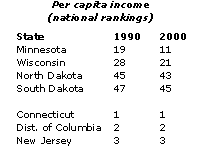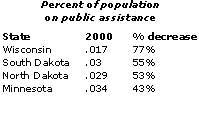By Art Hughes
Minnesota Public Radio
June 4, 2002
Minnesota is among the states with the lowest number of people living below the poverty line. New rankings by the U.S. Census Bureau released Tuesday show Minnesota second to the bottom in both individuals and families in poverty, and fifth overall in the greatest number of people emerging from poverty since 1990. The state is 11th in the nation for median income.
| |
|
|
|
||
Only New Hampshire has a lower percentage of people below the poverty line than Minnesota. The state's ranking of individuals in poverty dropped from 38th in 1990, to 50th of all the states and the District of Columbia, in the 2000 census. Only four other states saw a larger decline in poverty numbers.
The rankings bolster other census numbers released Monday showing sharp declines in poverty, and rising incomes statewide.
Chuck Johnson, director of the Families with Children Division of the state Department of Human Services, says the rising national economy is clearly at play in Minnesota. But he says the state fared particularly well because of efforts to educate the workforce, and focus welfare reform to give people skills to rise out of poverty.
"We support families, supplement their income when they go to work if they're not earning enough to get them out of poverty, provide childcare assistance, medical help if they need help paying their medical bills," says Johnson. "And those kinds of supports that help families - not get into just a job, but to succeed in work - and be able to move up the ladder to a job where they can support themselves and their family."
| |
|
|
|
||
Minnesota ranks 20th compared to other states in the percent of residents receiving public assistance. Wisconsin has the lowest percent in the nation. It was the first state to enact welfare reforms - an effort repeated on a national level with welfare to work programs - limiting the amount of time a person can receive public assistance.
Some people who work with people in poverty warn that policies like welfare reform worked well when the economy is good, but the system will see its most significant test as the good times weaken.
Bruce Bjork is director of programs for the Greater Minneapolis Council of Churches, which works with people who are chronically unemployed, and victims of domestic abuse. He says a rising tide may lift all boats, but when the tide goes back out, those boats closest to shore get grounded first.
"We have a lot of folks who have benefited from a stronger economy. But the ones who are most vulnerable to losing their jobs, and finding themselves back in poverty, are the ones who left welfare most recently," says Bjork.
Minnesota's median household income of $47,000 is the 11th highest in the nation, up from 17th in 1990. Minnesota had the fifth largest increase in median income in the country. But those numbers represent people's reported incomes from 1989 to 1999, and don't reflect the softened economy since then.
| |
|
|
|
||
Sue Kainz of Minnesota FoodShare, a statewide food program for people struggling to make ends meet, says the '90s were good for Minnesota. But she says her program saw a 10 percent jump in clients in 2001.
"We were always celebrating in the '90s as those numbers kept going down, and that's what those census numbers show us," says Kainz. "But now, as we continue to see the upswing again, I think we all hope the economy will turn around and we'll be back where we were in the '90s."
Kainz also says just because someone is above the government's definition of poverty doesn't mean they're living comfortably.
"There are not too many families that can live on $17,000 - certainly not in Minnesota. It's a high cost of living here," says Kainz. "Affordable housing - that's a huge issue now we're talking about. Rents are sky high. I mean there's just a lot of people can't even afford to find a place to live."
About 8 percent of Minnesotans were below the poverty line in 2000, compared to 10 percent in 1990. The District of Columbia, Louisiana and Mississippi have the greatest percentage, each with about one in five people living in poverty.
All of the numbers are based on responses to questions on income on the Census 2000 long form, which was sent to about one in six households nationwide.
More from MPRMore Information



